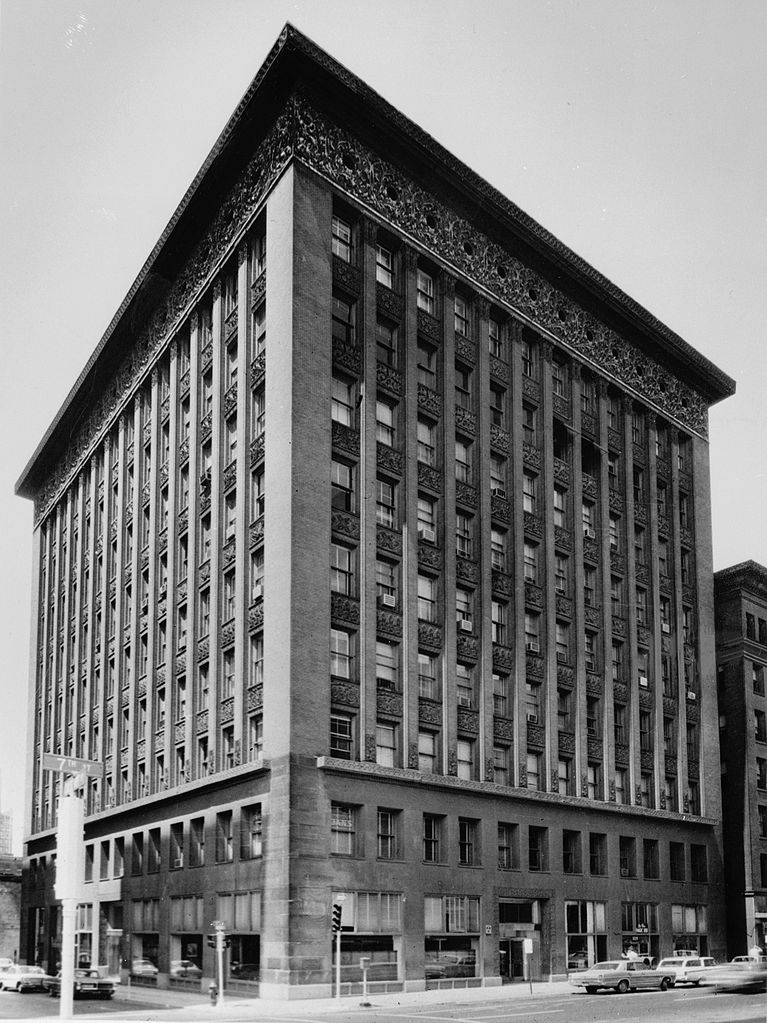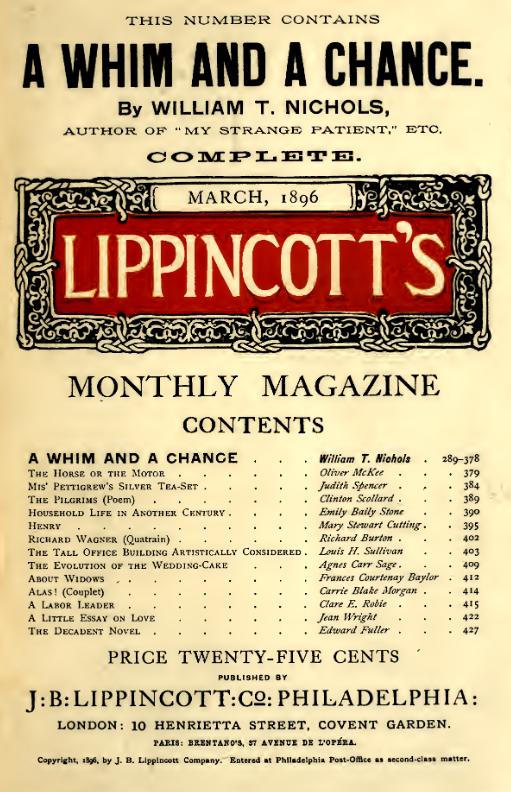There are, we would argue, three phrases that have come to popularly define modernist architecture and design: "Ornament is crime", "Less is more" and "Form follows function".
The first is derived from the 1908 text "Ornament and Crime" [Ornament und verbrechen] by the Austrian architect Alfred Loos.
The second is most commonly associated with Ludwig Mies van der Rohe, although its origins are much, much, older.
The latter can be found in American architect Louis H. Sullivan's essay "The tall office building artistically considered", first published in Lippincott's Monthly Magazine on March 1st 1896.
Born in Boston, Massachusetts on September 3rd 1856 as the second and youngest child of Irish migrant Patrick Sullivan and Swiss émigré Adrienne Sullivan (nee List), Louis Henry/Henri Sullivan began studying architecture at the Massachusetts Institute of Technology, M.I.T, in September 1872, aged just 16. With the glorious impatience of youth in his belly Louis Sullivan left M.I.T. after a year with plans to gain practical work experience before heading to Paris to continue his studies at the Ecole des Beaux Arts. Following stations in first Philadelphia where he worked in the office of Furness & Hewitt and subsequently with Major William LeBaron Jenney in Chicago, Sullivan set sail for France in July 1874 and enrolled in the Ecole des Beaux Arts in October of that year. Following two years in Paris Sullivan, again, became impatient with his lot and returned to Chicago. Where he was to remain. In 1880 Louis Sullivan entered the employment of his later business partner Dankmar Adler, and his first buildings originate from the same year. Among Louis Sullivan's most notable projects are the Union Trust Building and the Wainwright Building in St Louis, the Auditorium Building Chicago and the Transportation Building for the 1893 World's Columbian Exposition in Chicago, a work which Ralph Marlowe Line in his forward to the 1956 edition of "Louis Sullivan, The Autobiography of an Idea" describes as, "the building from which modern architecture as a movement is generally conceded to have begun". In addition to his architectural works Louis Sullivan published numerous texts including deliberations on the use of ornamentation in architecture, the emotional nature of building as well as modern architecture in general. Louis H. Sullivan died on April 14th 1924 in Chicago. In a time and city where many of his ideas were becoming reality.

Sullivan's most famous tenet arose, as the title suggests, in context of an essay in which he presents his position on one of the most pressing architectural questions of the period; how tall office buildings should be planned and constructed.
Increasing prosperity and industrialisation in the late 19th century was fuelling demand for ever more office, commercial and urban residential space; metal reinforced concrete was allowing the construction of ever taller buildings, which offered a technical solution to the problem; while through the development of mechanical elevators with inbuilt security systems to prevent them crashing to the ground, such tall buildings were not only becoming practical but were achieving ever loftier altitudes.
Louis Sullivan's position on the subject took a decade or two to become the succinct formulation we all know today, and his path there was largely directed by three men: John Edelmann, Charles Darwin and Monsieur Clopet.
While working for Major Jenny in Chicago Louis Sullivan developed a close friendship with the draughtsman John Edelmann. During one of their many theoretical discussions Edelmann explained his theory of "suppressed functions". Sadly Sullivan never elucidated on exactly what Edelmann understood by "suppressed functions"; however, by common consensus it is understood to involve the belief that the form of buildings was defined by architectural tradition, and that as a result the functionality of a building was always subservient to its form. Unless the architect could tweak the internal organisation and/or layout somehow. However, regardless how John Edelmann explained his theory, it had an immediate effect on the young Louis Sullivan, and, as he notes in his biography - a work he penned unnecessarily vaingloriously in the third person - "Louis, startled, saw in a flash that this meant the real clue to the mystery that lay behind the veil of appearances. Louis was peculiarly subject to the shock from unexpected explosion of a single word; and when the word "function" was detonated by the word "suppressed" a new, an immense idea came suddenly into being and lit up his inner and his outer world as one. Thus with John's aid Louis saw the outer and the inner world more clearly, and the world of men began to assume a semblance, a form and a function. But, alas, what he had assumed to be a single vast veil of mystery that might perhaps lift of a sudden, like a cloud, proved in experience to be a series of gossamer hangings that must slowly rise up one by one...."
This lifting of the gossamer hangings then began in earnest in Paris.
Ahead of taking the entrance exam for the Ecole des Beaux Arts Louis Sullivan hired a certain Monsieur Clopet as his maths tutor.
As legend has it, at their first meeting Monsieur Clopet stared disapprovingly at the book Louis Sullivan carried under his arm, "Now observe", Louis Sullivan recalls Monsieur Clopet saying as he opened the book at random pages, "here is a problem with five exceptions or special cases; here a theorem, three special cases; another nine, and so on and on, a procession of exceptions and special cases. I suggest you place the book in the waste basket, we shall not need of it here: for here our demonstrations shall be so broad as to admit of NO EXCEPTION! At these words Louis stood as one whose body had turned to hot stone, while his brain was raging. Instantly the words had flashed, there arose a vision and a fixed resolve; an instantaneous inquiry and an instant answer. The inquiry: If this can be done in Mathematics, why not in Architecture? The instant answer: It can, and it shall be! No one has - I will! It may mean a long struggle; longer and harder than the tramp through the forest of Brown's Tract. It may be years from now before I find what I seek, but I shall find it, if otherwhere and otherwise, with or without guide other than my flair, my will and my apprehension. It shall be done! I shall live for that - no one, no thing, no thousand shall deter me."
The seriousness and intent with which he set forward this process can be gleaned from a comment made in his biography in relation to the establishment of Adler & Sullivan in 1881, some seven years after that meeting with Monsieur Clopet, "He could now, undisturbed, start on the course of practical experimentation he long had in mind, which was to make an architecture that fitted its functions - a realistic architecture based on well defined utilitarian needs"
A final important stone on the path was placed, indirectly, by Charles Darwin's Galapagos finches.
In November 1859 Charles Darwin had published his "On the origin of the species", and by all accounts the text greatly inspired the young Louis Sullivan. Indeed in his biography, Sullivan records that "in Darwin he found much food. The Theory of Evolution seemed stupendous"
How much food he found in Darwin, how well he nourished himself therefrom, and how perfectly it complimented the lessons of Monsieur Clopet and John Edelmann, can be clearly read in The tall office building artistically considered:
"All things in nature have a shape, that is to say, a form, an outward semblance, that tells us what they are, that distinguishes them from ourselves and from each other. Unfailingly in nature these shapes express the inner life, the native quality, of the animal, tree, bird, fish, that they present to us; they are so characteristic, so recognizable, that we say, simply, it is "natural" it should be so.
....
Whether it be the sweeping eagle in his flight, or the open apple-blossom, the toiling work-horse, the blithe swan, the branching oak, the winding stream at its base, the drifting clouds, over all the coursing sun, form ever follows function, and this is the law.
Where function does not change, form does not change. The granite rocks, the ever brooding hills, remain for ages; the lightning lives, comes into shape, and dies, in a twinkling. It is the pervading law of all things organic and inorganic, of all things physical and metaphysical, of all things human and all things superhuman, of all true manifestations of the head, of the heart, of the soul, that the life is recognizable in its expression, that form ever follows function. This is the law."
No suppressed functions. No exceptions. An architecture that fitted its functions.
"Form shall ever follow function"
Today in the wake of our experiences with Pop Art and Post Modernism we may not have the clear cut concepts of either "form" or "function" as was the case in late 19th century America; consequently, "form follows function" is an increasingly difficult premise. However, despite our contemporary problems with the unequivocality of the position it remains an important consideration, an important benchmark, if you will a convenient starting point for all design and architectural processes. And something one is free to ignore should that prove necessary.
Which we would argue is exactly what Louis Sullivan would have wanted.
For ultimately over the two decades of deliberations that lead him to "form follows function" what Louis Sullivan is actually understanding is that if you want to achieve something new, if you want to progress and evolve, then ignore convention, let no "dictum or tradition or superstition or habit" stand in the way, think outside the box and create that which fits your requirements, your needs, your situation. For ultimately "man's spirit must be free that his powers may be free to accomplish in beneficence."
In 1896 the problem for Louis H. Sullivan was tall office buildings. For you in 2014 it is.......?
